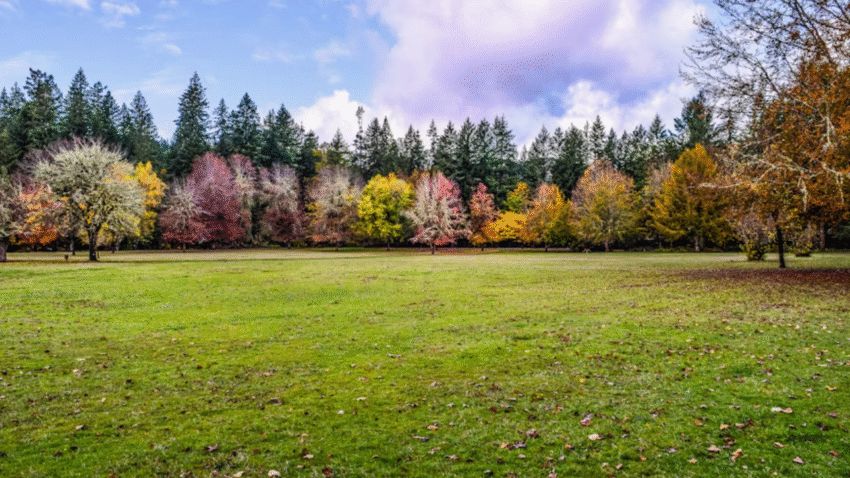Introduction
Does your lawn look thin, patchy, or struggle with compacted soil after a long summer of foot traffic and heat? Fall is the best time to give your grass the boost it needs to grow deep, healthy roots. Learning how to aerate your lawn in fall helps you break up soil compaction, improve nutrient absorption, and set up your grass for thicker, greener growth come spring. This complete guide shows you how to do it step by step for the best results.
Why Fall Aeration Matters for a Healthy Lawn
Your lawn’s roots need air, water, and nutrients to grow deep and strong. Over time, heavy use, foot traffic, and weather compact the soil — squeezing out the spaces roots need to breathe. A hard, compacted lawn means:
- Shallow roots that can’t find water or nutrients.
- Water puddles or runs off instead of soaking in.
- Thatch buildup that blocks air and moisture.
- Thin grass that struggles to compete with weeds.
Aerating your lawn in fall — when grass is actively growing roots — helps your turf recover from summer stress and store nutrients before winter. It’s one of the best steps you can take to ensure a thick, resilient lawn next year.
Step-by-Step Guide to Aerate Your Lawn in Fall
Step 1: Know When to Aerate
Timing matters!
- Cool-season grasses (fescue, bluegrass, ryegrass) should be aerated in early to mid-fall. The soil is still warm, and roots grow vigorously.
- Warm-season grasses (Bermuda, zoysia, St. Augustine) are better aerated in late spring or early summer.
Aerate when your lawn is actively growing so it recovers quickly.
Step 2: Choose the Right Aerator
There are two main types:
- Spike aerators: Punch holes by pushing soil aside. Better than nothing, but they can compact soil around the holes.
- Core (plug) aerators: Remove plugs of soil about 2–4 inches deep and ½ inch wide. This reduces compaction more effectively and is the best option for most lawns.
✅ Pro tip: Rent a core aerator from a garden center or hire a pro if you have a large yard.
Step 3: Mow and Water First
- Mow your lawn slightly shorter than usual (about 2–2.5 inches) to make aeration easier.
- Water your lawn thoroughly 1–2 days before aerating. Moist (not soggy) soil is easier to penetrate and produces cleaner plugs.
Step 4: Mark Obstacles
Avoid costly damage by marking:
- Sprinkler heads
- Shallow irrigation lines
- Landscape lighting
- Invisible dog fences
Use flags or spray paint to outline them so you don’t accidentally punch holes through.
Step 5: Aerate Your Lawn
- Make multiple passes over heavily compacted areas or high-traffic spots.
- Run the aerator in different directions for better coverage.
- For small lawns, take your time and overlap each pass slightly.
✅ You should see thousands of little holes and scattered soil plugs across your yard.
Step 6: Leave Plugs on the Lawn
Don’t rake up the soil plugs! They will naturally break down with rain and mowing, returning beneficial microbes and nutrients to your soil.
If they’re too large, you can break them up with a rake or run over them with your mower.
Step 7: Overseed After Aerating (Optional but Recommended)
Aeration and overseeding are a perfect pair! The holes create an ideal environment for seeds to germinate and root.
- Spread quality grass seed that matches your lawn.
- Lightly rake to help seeds settle into the holes.
- Water gently and keep the soil consistently moist until seedlings establish.
Step 8: Apply Compost or Fertilizer
Top-dressing your lawn with a thin layer of compost after aerating adds organic matter and improves soil structure.
- Spread ¼–½ inch of compost evenly across the lawn.
- Lightly rake to settle it into the holes.
- You can also apply a balanced fall fertilizer to feed roots before winter.
Step 9: Water Well
Keep your lawn lightly moist for a few weeks after aerating — especially if you’ve overseeded. Water deeply but less frequently once the new grass is established.
Common Aeration Mistakes to Avoid
Mistake #1: Aerating When the Soil is Too Dry or Too Wet
Bone-dry soil is hard to penetrate, and soggy soil can make a mess. Solution: Water the day before so soil is damp but firm.
Mistake #2: Using a Spike Aerator on Heavy Clay Soil
Spiking can actually make compaction worse. Solution: Always choose a core aerator for compacted or clay-heavy lawns.
Mistake #3: Raking Up Soil Plugs
You’re losing valuable soil and microbes. Solution: Let plugs break down naturally.
Mistake #4: Skipping Overseeding
You’re missing a big opportunity to thicken your lawn. Solution: Always overseed thin areas after aerating.
Mistake #5: Aerating at the Wrong Time
Aerating when your grass is dormant stresses turf. Solution: Do it during active growing periods — fall for cool-season, spring for warm-season grasses.
Extra Lawn Care Tips & Hacks
✅ Use a Rain Gauge
Track rainfall to avoid overwatering after aeration.
✅ Test Your Soil
Aeration is a good time to test your soil’s pH and nutrient levels. Adjust if needed.
✅ Plan Yearly Aeration
Once a year is best for most lawns. Heavy clay or high-traffic yards may benefit from twice a year.
✅ Check Out Our Overseeding Guide
For even better results, read our full guide on how to reseed your lawn for thicker grass after aerating.
Conclusion
Learning how to aerate your lawn in fall is one of the best steps you can take for a thicker, healthier yard that stays resilient all year long. Aerating breaks up compacted soil, improves drainage, and gives roots room to grow deep and strong.
Combine aeration with overseeding, compost top-dressing, and smart watering, and you’ll build the foundation for a lush, green lawn that stands up to weeds, drought, and heavy use.
Bookmark this guide and revisit it each fall to keep your lawn thriving and ready for its best season yet!
